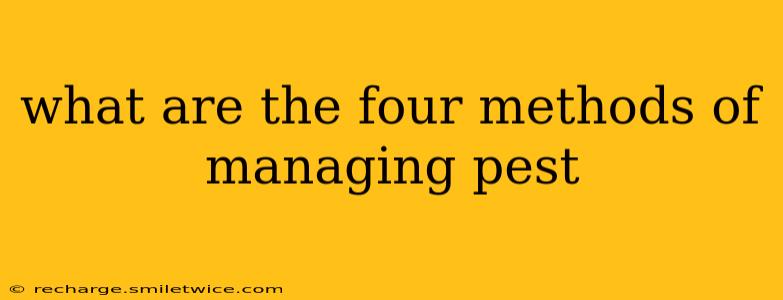The Four Main Methods of Pest Management: A Comprehensive Guide
Pest management is crucial in various settings, from agriculture and homes to businesses and public health. Effective pest control requires a strategic approach, and while eradication is sometimes the goal, more often the aim is to keep pest populations below economically damaging or health-threatening levels. This is typically achieved through a combination of methods. While there are many techniques within each category, the four main methods of pest management are:
1. Cultural Control:
This method focuses on modifying the environment to make it less hospitable to pests. It's a proactive approach aimed at preventing pest problems before they arise, often relying on manipulating the pest's habitat and life cycle.
- Examples:
- Crop Rotation: Alternating crops disrupts pest life cycles and reduces pest populations. For example, rotating corn with a legume breaks the cycle of corn rootworm.
- Sanitation: Removing debris, weeds, and other materials that pests use for shelter or food significantly reduces their populations. Cleaning gutters, removing fallen fruit, and regularly disposing of trash are all examples.
- Proper Watering and Fertilization: Balanced nutrition strengthens plants, making them more resistant to pests and diseases. Overwatering can create ideal conditions for fungal growth, attracting pests.
- Resistant Varieties: Planting pest-resistant crop varieties reduces the need for chemical interventions. Breeders constantly develop new varieties with improved pest resistance.
- Traps and Barriers: Simple, non-toxic physical barriers can prevent pest entry. Examples include mesh screens on windows, sticky traps for insects, or fences to keep out larger animals.
2. Biological Control:
This method uses natural enemies of pests to control their populations. It harnesses the power of nature to manage pests sustainably.
- Examples:
- Predators: Introducing natural predators like ladybugs to control aphids, or parasitic wasps to control caterpillars.
- Parasitoids: These insects lay their eggs in or on the host pest, eventually killing it. They are highly specific to certain pests and offer a highly targeted approach.
- Pathogens: Using naturally occurring bacteria, fungi, or viruses to infect and kill pests. Bacillus thuringiensis (Bt) is a well-known example used to control various insect pests.
- Competitors: Introducing organisms that compete with pests for resources, thus limiting their growth.
- Sterile Insect Technique (SIT): Releasing large numbers of sterilized male insects into the environment to mate with wild females, resulting in no viable offspring.
3. Chemical Control:
This method uses pesticides to kill or repel pests. While effective, it should be used judiciously and cautiously, prioritizing other methods whenever possible due to potential environmental and health impacts.
- Examples:
- Insecticides: Target insects.
- Herbicides: Target weeds.
- Fungicides: Target fungi.
- Rodentides: Target rodents.
- Nematicides: Target nematodes.
Important Note: The selection of pesticide is crucial and should consider the specific pest, the environment, and potential non-target effects. Always follow label instructions carefully.
4. Mechanical Control:
This method involves physically removing or trapping pests. It's a direct and often labor-intensive approach.
- Examples:
- Handpicking: Manually removing pests from plants.
- Trapping: Using various types of traps to capture and remove pests, such as glue traps for insects or snap traps for rodents.
- Vacuuming: Removing pests and their debris with a vacuum cleaner.
- Physical Barriers: Using screens, netting, or other physical barriers to prevent pests from accessing areas.
Choosing the Right Method:
The best pest management strategy often involves an integrated pest management (IPM) approach, combining several of these methods to achieve the most effective and sustainable control. IPM emphasizes prevention, monitoring, and targeted interventions, minimizing reliance on harmful chemicals and maximizing environmental protection. The specific methods used depend on the type of pest, the environment, and the acceptable level of pest damage.
